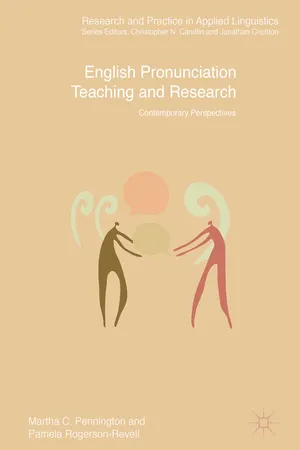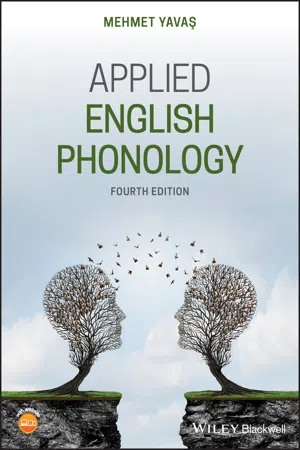Languages & Linguistics
Word Pronunciation
Word pronunciation refers to the way in which a word is spoken or articulated. It involves the correct enunciation of sounds, stress patterns, and intonation. Proper pronunciation is essential for effective communication and is influenced by various factors such as regional dialects, accents, and phonetic rules. Mastering word pronunciation is crucial for language learners and speakers to be understood clearly.
Written by Perlego with AI-assistance
3 Key excerpts on "Word Pronunciation"
- eBook - ePub
English Pronunciation Teaching and Research
Contemporary Perspectives
- Martha C. Pennington, Pamela Rogerson-Revell(Authors)
- 2018(Publication Date)
- Palgrave Macmillan(Publisher)
phonology .Researchers and practitioners with a practical or applied emphasis may use any of these terms (phonology , pronunciation , or phonetics ) together with others, such as articulation , relating to the mechanics of producing speech sounds (e.g., speech therapists), or accent , relating to the general characteristics of speech that are associated with a certain geographical locale or social group (e.g., managers and trainers in business). Social psychologists may refer to pronunciation or accent as a focus of investigation on people’s attitudes to specific languages or speaker groups. Because we aim to focus on the practical aspects of phonology, we will refer to pronunciation for the most part, while using the other terms as appropriate for our coverage of research and practice in the various disciplines and areas of spoken language performance included in this book.As a type of linguistic skill or language proficiency, pronunciation involves learning to articulate and discriminate the individual sound elements or phonemes making up the system of consonants and vowels of a language, sometimes referred to as segmental phonology , and the features of connected speech making up its prosody or prosodic system , sometimes referred to as suprasegmental phonology . The prosodic system or suprasegmental phonology includes, at a minimum,toneandintonation(defined by pitch),rhythm(defined by duration), andstressoraccentuation(defined by acoustic intensity , force of articulation , or perceptual prominence ). From the perspective of language teaching, prosody may also include articulatory (or vocal ) setting , a complex of specific postures of the vocal organs (lips, tongue, jaw, and vocal folds), and/or voice quality - eBook - ePub
- Mehmet Yavas(Author)
- 2020(Publication Date)
- Wiley-Blackwell(Publisher)
1 Phonetics1.1 Introduction
Our aim in this book is to study the sound patterns of English. The understanding of phonological patterns cannot be done without the raw material: phonetics. In order to be able to come up with reliable phonological descriptions, we need to have accurate phonetic data. Thus, students and professionals who deal with the patterns of spoken language in various groups of speakers (linguists, speech therapists, and language teachers) need a basic knowledge of phonetics.Phonetics, which may be described as the study of the sounds of human language, can be approached from three different perspectives. Articulatory phonetics deals with the physiological mechanisms of speech production. Acoustic phonetics studies the physical properties of sound waves in the message. Auditory phonetics is concerned with the perception of speech by the hearer. The coverage in this book will be limited to the first two of these approaches. The exclusion of auditory phonetics is basically due to the practical concerns of the primary readership as well as the little information available about the workings of the brain and speech perception. In this chapter, we will look at the basics of speech production. Acoustic properties, in a limited form of spectrographic analysis and waveform analysis, will be the subject of Chapter 5 .1.2 Phonetic Transcription
Because we are constantly involved with reading and writing in our daily lives, we tend to be influenced by the orthography when making judgments about the sounds of words. After all, from kindergarten on, the written language has been an integral part of our lives. Thus, it is very common to think that the number of orthographic letters in a word is an accurate reflection of the number of sounds. Indeed, this is the case for many words. If we look at the words pan, form, print, and spirit, for example, we can see the match in the number of letters (graphemes) with the number of sounds: three, four, five, and six, respectively. However, this match in number of graphemes and sounds is violated in so many other words. For example, both should and choose have six graphemes but only three sounds. Awesome has seven graphemes and four sounds, while knowledge - eBook - ePub
- Dr Geoffrey Broughton, Geoffrey Broughton, Christopher Brumfit, Anita Pincas, Roger D. Wilde(Authors)
- 2002(Publication Date)
- Routledge(Publisher)
The layman who thinks that the stream of speech is merely a sequence of isolatable sounds, which, once learned, merely have to be strung together, is making the same mistake as the person who conceives of language in general as merely strings of words. The truth is that in the area of sounds, as in all other areas of language, structure is all-important. Although separate sounds can be isolated, the characteristics they show in isolation will not be the same as the characteristics they have in the context of neighbouring sounds and the overall structure of the utterance. An oversimplified view of English phonology so frequently leads to a teacher's and his pupil's sense of failure. Having practised all the sounds with considerable effort, the pupils are dismayed to find that they still cannot understand some English speakers, let alone speak like them.The teacher must understand the way the sounds of English are systematically used within the sound structure of English, not in order to explain this to the students, but rather so that he can clarify his own objectives in pronunciation teaching. Phonology , the study of the sound system, is as vital to him as phonetics , the study of the physical properties of sounds and their place and manner of articulation in the vocal tract.The speech process consists of conveying a message through the medium of sound. The message is given shape by the vocabulary and grammar of the language, presented in a train of sounds. These sounds are organised in every language so that it is possible to distinguish one message, i.e. one bit of meaning, from another. Sounds used in a language are therefore distinctive so that words can be distinguished from each other when heard just as they can be distinguished when written. The word cat is distinguished from the word sat and from the word cot and from the word cad . In each case the difference of sound which makes the distinction in English is a phonemic difference, and the phonemes
Index pages curate the most relevant extracts from our library of academic textbooks. They’ve been created using an in-house natural language model (NLM), each adding context and meaning to key research topics.
Explore more topic indexes
Explore more topic indexes
1 of 6
Explore more topic indexes
1 of 4


